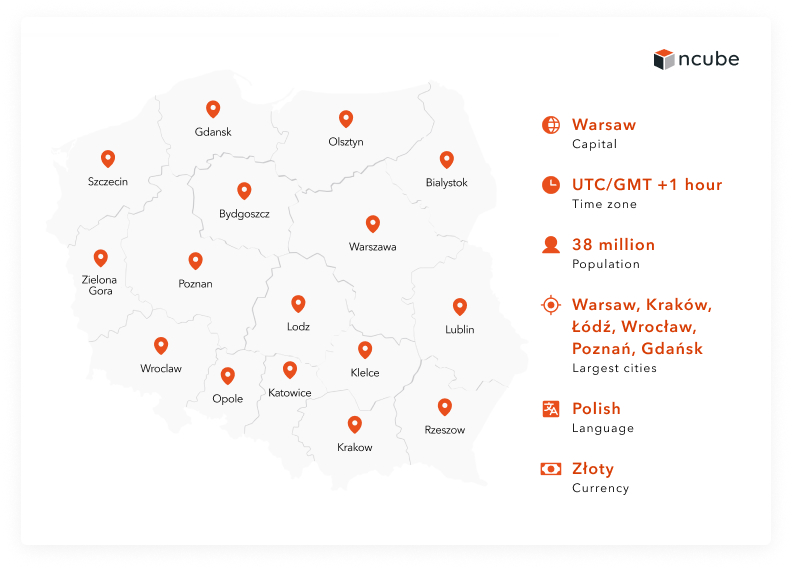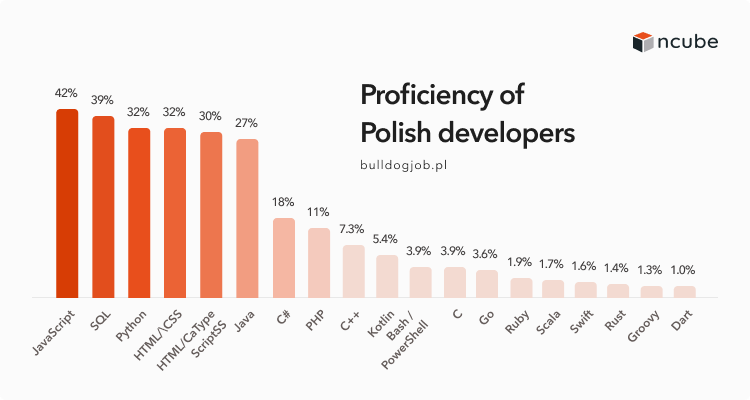
Nearshoring to Poland in 2024: What Should you Know About it?

If you need to back up your already-existing tech unit or create a remote team from scratch, nearshoring to Poland sounds like a solid plan. As a software development company with a network of 100,000+ software engineers located across Central & Eastern Europe, our team is expertly skilled in the local talent market. In this post, we’ll focus on how software nearshoring to Poland can positively impact your software development efforts, highlighting its distinct features in the context of other tech hubs in the CEE region. Let’s begin with a short definition.
What is nearshoring?
Nearshoring is the practice of contracting out work to be performed in a nearby country. Although the term is similar to outsourcing, its meaning implies particular geographical proximity to the chosen country, while outsourcing is an umbrella term for all business activities performed abroad. Nearshoring is also different from offshoring as it covers transferring operations to a neighboring country rather than one that is further away. Now, let’s focus on software development in Poland.
READ ALSO: Types of Software Development Companies in Poland
Overview of IT nearshoring in Poland

In 2024, Poland’s IT services market shows competitiveness, growth, and recognition both globally and regionally. Below are several key numbers regarding nearshoring in Poland to bolster this statement.
Poland, according to Emerging Europe, boasts the most competitive IT sector among 23 countries in CEE. With a robust CAGR of 7.60% expected by 2028, it’s one of the largest markets of IT services in Europe.
The IT Competitiveness Index in Central and Eastern Europe (CEE) places the country third in the region, surpassed only by Estonia and Lithuania. The country deserves such a high score due to the quality of software developers, the overall development of the IT sector, and the business climate.
The tech industry plays a significant role in the Polish economy. It’s accountable for 8% of the local GDP. In 2024, the IT services market shows dynamic growth and is expected to reach $8.31 billion.
When it comes to the exports of IT services (one of its forms is nearshoring), Poland is expected to reach $13 billion by 2026. It’s a 3.6% growth as compared to $10 billion in 2021.
When it comes to the global recognition of outsourcing in Poland, in 2023, the country took the 4th position as the most favored Customer Experience delivery point. It’s the only European destination to secure a position in the top 5.
Finally, according to the Global Innovation Index (GII) 2023, Poland ranks 41st among 132 economies, which is an indication of a determined focus on exporting IT services.
Software development in Poland: IT companies and domains
Poland has carved a strong position in the global software industry. It’s home to nearly 50,000 tech companies of various sizes, including 10 unicorns. The country also ranks within the top 40 startup ecosystems in the world, with strong innovation potential in Marketing & Sales, Hardware & IoT, and Healthtech.
Over 1,300 companies offer software development in Poland, as per Clutch. Such a number can be chalked up to the availability of a skilled, well-educated IT workforce in the market.
Another important factor in the growth of nearshoring in Poland is the increasing trend of foreign companies tapping into its talent pool. Capgemini, Amazon, Sii, Accenture, and IBM are the five tech behemoths that shape the Polish tech scene. These foreign-invested enterprises have development centers scattered across various regions of Poland. Moreover, these companies take the lead in employment – they are accountable for employing 36,000+ IT specialists.
Google, Samsung, Facebook, Amazon, Intel Google, Microsoft, Oracle, Nokia, and Cisco are other notable players in the market of software development in Poland. On the one hand, it’s a great testiment of a talent pool quality. On the other hand, the competition for engineers is growing rapidly pushing salaries up.
Finally, according to the Source Seek report, Polish software companies are strongly present in such domains as Security, Energy, Automotive, Education, and Finance & Banking.

Talent pool: The number, location, and skills of Polish developers
The population of Polish developers is the highest in the CEE region – the country boasts 430,000 technologists. This number is higher than that of its closest competitors, Ukraine (307,000 developers) and Romania (202,000 developers). Thus, nearshoring in Poland will give you access to almost a quarter of all developers available in CEE.

Geographically, the majority of Polish developers reside in the three major tech hubs, Warsaw, Kraków, and Wrocław:

When it comes to the proficiency of Polish developers, JavaScript, SQL, HTML/CSS, and Python top the list of the most common programming languages. Here’s a full breakdown:

Software development in Poland is a diverse landscape. The share of programmers in the overall pool of developers is at 53%. Other IT roles in the pool include:
- Quality Assurance expert (14%)
- DevOps/IT Administrator (10%)
- Project Manager/Product Owner (6%)
- Business Intelligence expert (5%)
- Data Science/ML/AI expert (2.9%)
- UX/UI designer (2.1%)
- Software Architect (1.7%)
The salary of Polish developers
The salary range of Polish developers is based on three types of employment contracts, such as Job Contracts, B2B Contracts, and Contracts For Specific Work. As a service company, we analyzed the data concerning B2B contracts. Here’s the average salary for this type of contract in 2023:

Furthermore, we dived into various job boards to analyze the salary ranges of Polish developers in various technologies to see the current trends. So, here’s the salary of Polish developers in terms of technology based on our speculation:

Another significant report, shows the range of rates for software development in Poland.

Nearshoring in Poland: Education
Nearshoring in Poland is driven by well-educated IT specialists. The country is home to 86,000 IT students, with 11,000 IT professionals graduating each year. Moreover, Poland ranks third among EU countries in the number of graduates in natural sciences, technology, and IT per 1000 population aged 20–29.
According to the survey, over two-thirds of Polish IT specialists have higher education, including 39% with Master’s degrees. Only 8% of respondents completed their studies without a diploma and acquired tech skills through self-education.

Furthermore, Poland boasts over 400 institutions, 22 of which are featured in the QS World University Rankings 2024. The country’s 18 technical universities, including the famous AGH University of Science in Kraków and Warsaw University of Technology, contribute to the quality of technologists available for nearshoring in Poland.
English skills of Polish developers
Polish developers have a solid command of the English language, with B2+ as an average proficiency level. As per the EF EPI index, in 2023, the country was ranked 11th globally and 9th in Europe, which solidifies its status as a country with “very high proficiency.”
The focus on technical education, coupled with Poland’s excellent English language skills, makes outsourcing in Poland particularly lucrative for international clients. Moreover, the proficiency extends beyond English, which is crucial for nearshoring. In Poland, many ICT graduates are proficient in other European languages such as German, French, Spanish, or Italian.
Why use nearshore IT services in Poland?
There are many factors to consider when deciding which countries are suitable for nearshoring. One important factor is the availability of skilled workers. CEE has a large pool of IT specialists, making it an attractive option for companies looking to nearshore. Additionally, labor costs in CEE are typically lower than in Western Europe, making it a more cost-effective option.
Nearshoring to Poland is an increasingly popular option for Western businesses thanks to its relatively low costs, well-developed infrastructure, and a large pool of English-speaking talent. Poland is also located in Central Europe, making it easily accessible for businesses based in the region. There are many reasons to go with software nearshoring in Poland, including the following:
- Poland has a large pool of highly-educated and skilled workers, especially in engineering and programming. It makes it easy to find talented staff for your nearshoring team in Poland.
- The cost of living and doing business in Poland is relatively low compared to Western European countries.
- Poland has a large population of highly-educated, English-speaking workers.
- Poland is situated in a convenient location for companies who want to do business in both Eastern and Western Europe.
- The Polish government is very supportive of foreign investment and has created several special economic zones that offer tax incentives to companies.
- Poland is in the same time zone as much of Europe, making coordination and collaboration between teams easy.
- As a member of the European Union, nearshoring to Poland offers businesses access to a large and lucrative market.
- Poland has a stable political and economic environment, which provides a secure and predictable business environment that can help reduce risks associated with running an IT operation.
- Poland is home to some of the world’s leading technology companies, such as Accenture, IBM, Cisco, Uber, and more. It provides access to the latest tools and technologies to help your business stay ahead of the competition.
Bottom line
There are many reasons to nearshore IT services to Poland, but some of the most common reasons include reducing costs, accessing skilled labor, and improving communication. Let’s
- Reducing costs. When companies choose to nearshore, they often do so to take advantage of lower wages in other countries. Nearshoring services in Poland can help reduce costs associated with labor, infrastructure, and other overhead expenses.
- Accessing a skilled workforce. One of the most significant advantages of nearshoring is that it provides access to skilled labor that may be difficult to find in your home country. When companies go with a nearshore approach, they get the advantage of lower wages in other countries. Nearshoring also eliminates the need for expensive infrastructure and other overhead costs associated with traditional outsourcing.
- Improving communication. Another crucial advantage of nearshoring in Poland is that the country is located in a convenient time zone. It gives a comfortable overlap for unimpeded communication between the teams.
- Staying flexible. Decent nearshoring to Poland gives you the ability to scale your workforce up or down as needed, allowing you to be more agile in responding to changes in demand.
- Increasing efficiency. When nearshoring to Poland (or any other country), you can improve communication and collaboration by locating your team closer to your customers, leading to an increase in the team’s productivity.
- Enhancing customer satisfaction. With nearshoring, you can provide your customers with a local point of contact, improving customer satisfaction.
Contact us to discuss your needs and let’s see if nearshoring to Poland is a viable option for you.
Recommended articles


